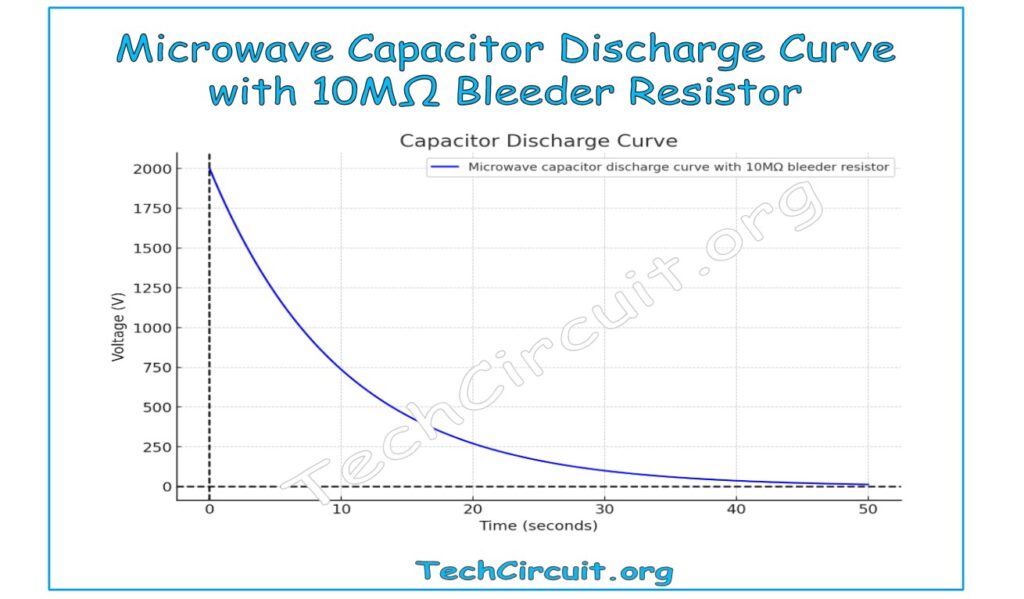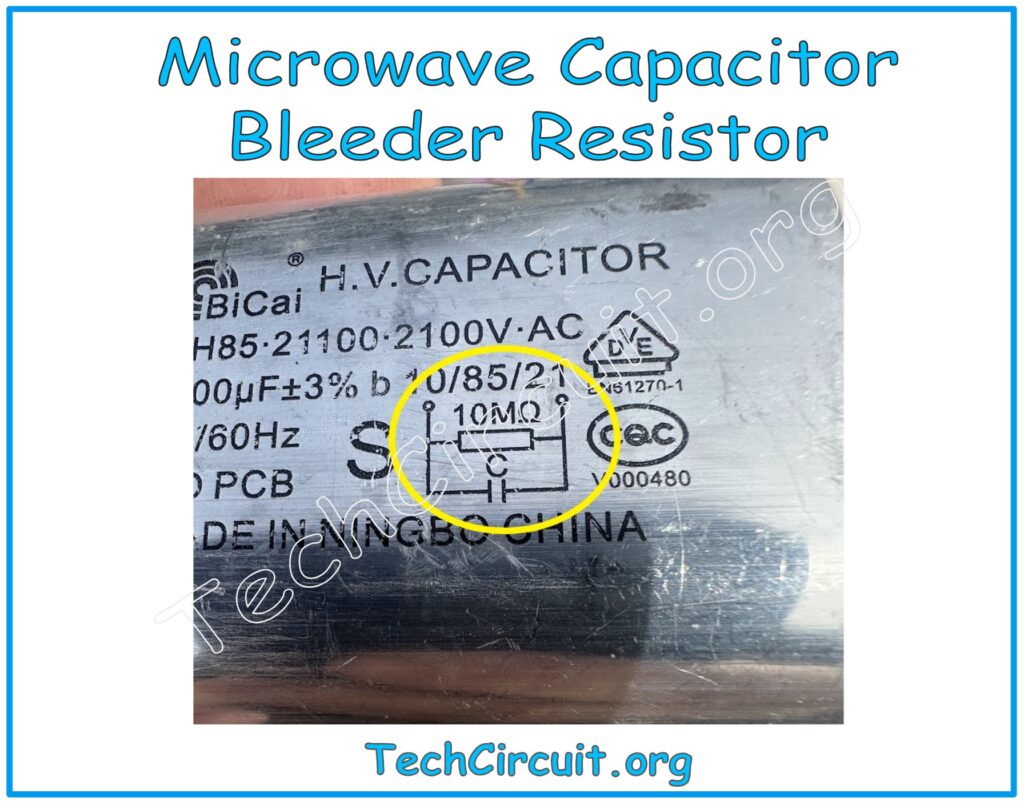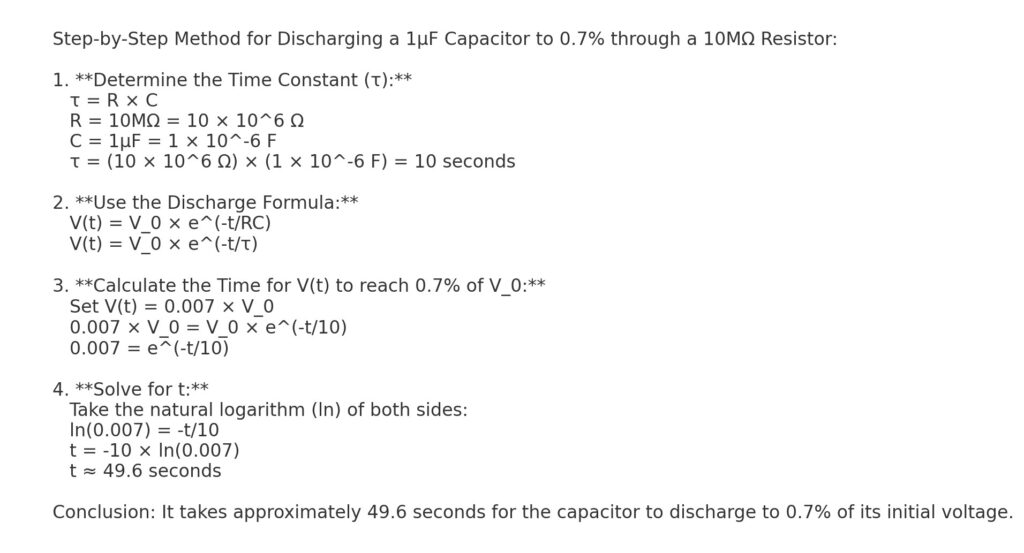
Intro
In the 1970’s bleeder resistors on microwave oven high-voltage capacitors started coming into the picture amid safety concerns. By the early 1980’s they started becoming more standard. However, there are plenty of units out there without bleeder resistors, that can hold a charge for a very long time (weeks to even months), due to their very low internal leakage current. This makes them potentially very dangerous to the unwary technician or DIYer that comes into electrical contact with that voltage during service.

Disclaimer:
THIS BLOG IS INTENDED FOR APPLIANCE TECHNICIANS AND IS FOR INFORMATIONAL PURPOSES ONLY. ALWAYS FOLLOW PROPER SAFETY PRECAUTIONS WHEN WORKING WITH ELECTRICITY. USE THE CONCEPTS DISCUSSED AT YOUR OWN RISK. THE AUTHOR ASSUMES NO RESPONSIBILITY FOR ANY OUTCOMES, ERRORS, OR OMISSIONS. ADDITIONALLY, SINCE MICROWAVE OVENS CAN STORE LARGE VOLTAGES AND RESULT IN SERIOUS ELECTRICAL SHOCK, I RECOMMEND THAT MICROWAVE CAPACITORS ALWAYS BE DISHARGED REGARDLESS OF THE PRESENCE OF A BLEEDER RESISTOR, AND THAT ANY MICROWAVE OVEN REPAIRS BE PERFORMED BY A QUALIFIED APPLIANCE REPAIR TECHNICIAN.
The Internal Bleeder Resistor
The bleeder resistor value of 10MΩ in our example, is designed to discharge the capacitor in a reasonable amount of time, while posing a negligible impact on the voltage doubler circuit. It is in parallel with the capacitor, and is internal to the capacitor’s enclosure. Capacitors discharge in an exponential fashion when supplying current to a fixed resistance. This results in the specific discharge curve as shown below:

Be sure to subscribe to our Youtube Channel!
For tons of videos on electrical and electronics diagnostics, practical electrical theory, and field-technician resources, click the picture below or this link here: https://www.youtube.com/@TheTechCircuit?sub_confirmation=1

How Long to Discharge the Capacitor?
The 1uF capacitor and 10MΩ resistor are in parallel with each other, which causes the capacitor to discharge through the resistor when it is powered down. In such an arrangement, the capacitor and resistor values form what’s known as a time constant with units in (seconds). This time constant is such that the capacitor will discharge by 99.3% after 5 of these time constants. If the capacitor starts out at 2000V, when powered down it will drop to 0.7% of that value after 5 time constants, or 14V. This is a save voltage level to work with. The specific calculations are detailed in the next section.
Calculations
Finding the discharge time through a specific value resistor requires that you first find the “time constant” (τ), which is R x C, or in this case, 10,000,000Ω x .0000001uF which comes out to 10 seconds. From there, the math is fairly heavy, and in order to spare the reader from it, that sequence will be placed at the end of this article. The jest of it is though, for every time constant (10 seconds) the capacitor will have 36.8% of its previous voltage value. For example, when we start out, the capacitor has 2000V. After 1 time constant (RxC), it will be 36.8% of that, or 750V. After 20 seconds, we have 36.8% of 750V, or 270V, and so on. The convention is that after 5 time constants a capacitor is discharged by 99.3% or left with 0.7% of its original voltage.
Why is this Knowledge Important?
Knowing how long the capacitor takes to discharge the capacitor to a safe level is important for those that rely on the bleeder resistor (not recommended), is valuable information. Going a step further, we can calculate how much voltage is left on the capacitor after 10, 20, 30 seconds, etc., so that we’re cognizant of its state immediately after it is powered down. In cases where the technician is actively troubleshooting the microwave, he or she may shut it down and go right for the capacitor. This can be hazardous, because before the 50 seconds are up, dangerous voltages can still be present.
Voltage Left after 10, 20, 30, 40, and 50 Seconds
Given our calculated time constant of 10 seconds, we can say that the capacitor will discharge to 36.8% of its previous value after 10 seconds. We can then use this to determine the voltage at 10 second intervals as shown below
| Time in Seconds After Power-down | Capacitor Voltage Remaining |
| 0 | 2000V |
| 10 | 750V |
| 20 | 270V |
| 30 | 100V |
| 40 | 37V |
| 50 | 14V |
Capacitor Discharge Time Process and Formulae
For those that are interested, here is a method for finding the capacitor discharge time for a given capacitance and parallel (bleeder) resistor. “Discharge” is defined here as the time it takes for the capacitor’s voltage to be reduced by 99.3%, or left with 0.7% of it’s initial voltage.

Conclusion
Knowing how long it takes for a microwave capacitor to discharge through its bleeder resistor provides some situational awareness to Appliance Technicians that rely on that self-discharge process. Again, I recommend that you always discharge the capacitor regardless. This can be done by using an insulated screwdriver to make contact with both terminals of the capacitor. This should be done with one hand and with the other hand behind your back. Additionally, I recommend wearing rubber gloves and safety glasses. For self-discharge, the discharge rate is based on a specific formula that is based on the value of the capacitor (1uF in our case), and its internal bleeder resistor (10MΩ in our case). Although the process and formula for determining the discharge time is a bit math intensive, we can shortcut it by finding the time constant (R x C), and after five of those time constants, the capacitor is deemed to be at only 0.7% of its original value, which for the microwave cap is about 14V.
Going a step further, we can determine what voltage is left incrementally (after 10, 20, etc. seconds), by using the 36.8% rule. This states that after each time constant (10 seconds for this case), the capacitor is left with 36.8% of its last calculated voltage value.
The bleeder resistor, which is responsible for discharging the capacitor, became more standard in the 1980’s, and serves as a risk mitigation tool for those working on microwave ovens. It has likely saved lives, but should not be relied upon.
What did you Learn from this Article? Test your Knowledge!
Understanding Microwave Oven Capacitors
Select the best answer for each question.
Don’t forget:
“Diverting 10 min/day of social media time towards learning something new, is 5 hours of newfound monthly knowledge.” – SM
To DONATE to the Tech Circuit – CLICK HERE
Alphabetical Links to all Tech Circuit Articles and Blogs – CLICK HERE
Links to all Tech Circuit Cheat Sheets/Field References for Appliance/HVAC Techs – CLICK HERE
For additional electrical and electronics learning material for field techs, visit the following links:
Homepage at http://www.TechCircuit.org
Facebook group at: https://www.facebook.com/groups/746823709133603
Youtube Channel: https://www.youtube.com/@TheTechCircuit
We are a participant in the Amazon Services LLC Associates Program, an affiliate advertising program designed to provide a means for us to earn fees by linking to Amazon.com and affiliated sites.
Capacitor Discharge Time Process and Formulae
For those that are interested, here is a method for finding the capacitor discharge time for a given capacitance and parallel (bleeder) resistor. “Discharge” is defined here as the time it takes for the capacitor’s voltage to be reduced by 99.3%, or left with 0.7% of it’s initial voltage.

